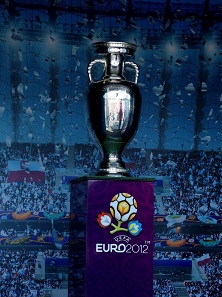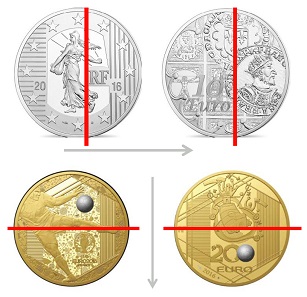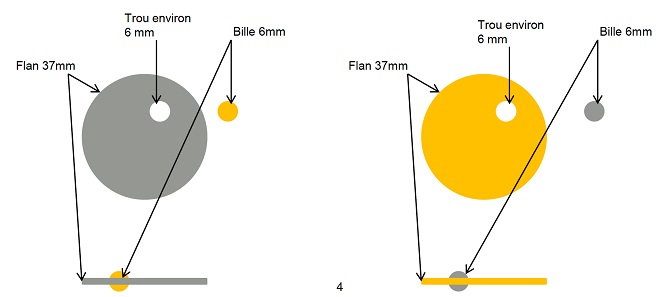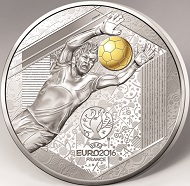April 14, 2016 – Organised every 4 years since 1960, the male European football UEFA championship, called “EURO”, will take place in France from 10th June to 10th July 2016. On this occasion France issues a series of coins.
It is the 15th edition of this competition organised by the UEFA gathering the best male European teams. France is the country that organised the highest number of times this event; indeed 3 times: 1960, 1984 and 2016.
The Delaunay trophy of the UEFA 2012. Photo: DrabikPany / https://creativecommons.org/licenses/by/2.0/deed.de
The Delaunay trophy
The creation of the trophy is to be awarded to Pierre Delaunay, son of Henri, creator of the competition. Among the time, the silver base of the trophy has been enhanced, enabling a better stability. The names of the competition winners are engraved on the back of the trophy. It weights 8kg and measures 60cm height. A nation that would win the competition three times in a row or five times would be presented with a full size replica.
UEFA 2016 France’s major sport event
For the first time, 24 teams will participate in the UEFA European Championship. As organising country, France is automatically qualified. The 23 other teams will join France within the 6 groups of 4 teams. This new format replaces the former one used for the last 4 tournaments.
The games of the UEFA EURO 2016 will take place in 10 different stadiums: Bordeaux, Lens, Lille, Lyon, Marseille, Nice, Paris, Saint-Denis, Saint-Étienne and Toulouse. The event’s mascot is Super Victor.
Starting with only 4 teams in 1960, the competition grew to reach 8, then 16 teams in the final phase of the competition. 2016 will be the first year with 24 teams, leading to add a fourth week to the duration of the event. Any team reaching the final will have played 7 games in total versus 6 in the prior competition. The Henri-Delaunay Trophy, named after the creator of the competition, is presented to the winning team in a smaller version.
Medal striking: usual custom (above) vs. coin striking: special custom (below).
The ball insert
The first step is piercing the blank with a hole corresponding to the diameter of the ball. During the strike: the blank is placed on the tooling and the ball is hand positioned in the blank’s hole and the pressure of the strike inserts the ball within the hole, while it also shows the engraving on both the blank and the ball (football motive).
Positioning of the ball insert.
The balls are in gilded silver 900 ‰ for the silver coins and in white gold 750 ‰ for the 1 Oz gold coin.
500 euros / 5oz 999 Gold / 50mm / 155.5g / Mintage: 99.
5oz gold, ¼oz gold, ½g gold, 5oz silver
The obverse depicts a player doing a volley kick. Behind the player, a composition made of traits symbolises the hexagon and the French flag. In the background, elements from the visual identity are forming a pattern whereas the competition’s logo fits in the centre of the coin. The reverse shows on the first plan a stylised football field using triumph arches as goals. In the’ background, the French flag in an hexagon is made of traits. The face value is inscribed using a football ball as a 0.
10 euros / 900 silver / 37mm / 22.7g / Mintage: 10,000.
10 euro silver ‘Head kick’
The obverse depicts a player doing a head kick. The ball he kicks is actually a gilded silver ball inserted through the blank during the strike. Behind the player, a composition made of traits symbolises the hexagon and the French flag. In the background, elements from the visual identity are forming a pattern whereas the competition’s logo fits in the centre of the coin. The reverse shows on the first plan a stylised football field using triumph arches as goals. In the’ background, the French flag in an hexagon is made of traits. The face value is inscribed using the gilded silver ball as the 0.
10 euros / 900 silver / 37mm / 22.7g / Mintage: 10,000.
10 euro silver ‘Goalkeeper’
The obverse depicts a goalkeeper doing a save. The ball he catches is actually a gilded silver ball inserted through the blank during the strike. Behind the player, a composition made of traits symbolises the hexagon and the French flag. In the background, elements from the visual identity are forming a pattern whereas the competition’s logo fits in the centre of the coin. The reverse shows on the first plan a stylised football field using triumph arches as goals. In the’ background, the French flag in an hexagon is made of traits. The face value is inscribed using the gilded silver ball as the 0.
Further denominations and issues are available. For more information go to the Monnaie de Paris website.
This is the official UEFA 2016 website and here you can also find more details on the Henri Delaunay Trophy.













